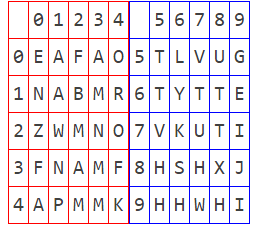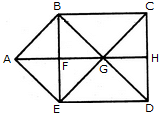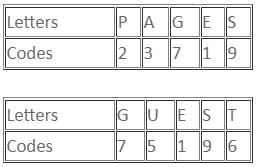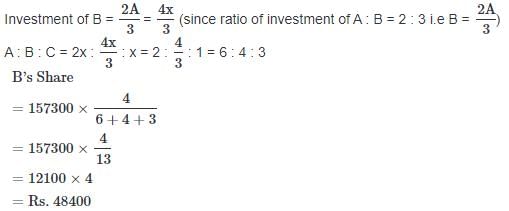Assam Police SI Mock Test - 3 - Assam Police SI MCQ
30 Questions MCQ Test Assam Police SI Mock Test Series 2025 - Assam Police SI Mock Test - 3
Two matrices are shown in the figure below. Their rows and columns are labelled as (0,1,2,3,4) and (5,6,7,8,9) in the manner shown. Find the correct row-column pairs out of the following matrices that decode to the word - MATH

In each of the following questions, you are given a figure (X) followed by four alternative figures (1), (2), (3) and (4) such that figure (X) is embedded in one of them. Trace out the alternative figure which contains fig. (X) as its part.
Question - Find out the alternative figure which contains figure (X) as its part.
 (X) (1) (2) (3) (4)
(X) (1) (2) (3) (4)
In each of the following questions, you are given a figure (X) followed by four alternative figures (1), (2), (3) and (4) such that figure (X) is embedded in one of them. Trace out the alternative figure which contains fig. (X) as its part.

In a row of girls, Veena is 12th from the start and 19th from the end. In another row of girls. Sunita is 14th from the start and 20th from the end. How many girls are there in both the rows together ?
What number is opposite 3 in the figure shown below? The given two positions are of the same dice whose each surface bears a number among 1, 2, 3, 4, 5 and 6.

In the following question assuming the given statements to be True, find which of the conclusion among given conclusions is/are definitely true and then give your answers accordingly.
Statement:
P > S ≥ M = L < J = N
Conclusions:
I. L < N
II. P > M
III. S = L
For a student to qualify for a certain course, the average of his marks in the permitted 3 attempts must be more than 60. His first two attempts yielded only 45 and 62 marks respectively. What is the minimum score required in the third attempt to qualify?
In a certain coding system, 'PAGES' is coded as 23719 and 'GUEST' is coded as 75196. How will you code 'STAGE' in this coding system?
Statements: Some bananas are apple. Some guavas are apples. Some grapes are guava.
Conclusion: 1) Some bananas are definitely grapes. 2) Some grapes being apple is a possibility 3) All apples being banana is a possibility.
A boy facing north turns 60’ in clockwise direction and then turns 150’ in anti clockwise. In which direction now he is facing.
Directions to Solve:
Choose the correct alternative that will continue the same pattern and replace the question mark in the given series.
Question: 1, 2, 3, 6, 9, 18, ?, 54
A and B can complete a task in 30 days when working together. After A and B have been working together for 11 days, B is called away and A, all by himself completes the task in the next 28 days. Had A been working alone from begining, the number of days taken by him to complete the task would have been:
In a business, A and C invested amounts in the ratio 2 : 1 , whereas the ratio between amounts invested by A and B was 3 : 2 . If Rs 157300 was their profit, how much amount did B receive?
Two places A and B are at a distance of 480Km. Sita started from A towards B at the speed of 40Kmph. After 2 hours Gita started from B towards A at speed of 60 Kmph. They meet at a Place C then what is the difference between the time taken by them to reach their destinations from Place C?
A sum of Rs. 600 amounts to Rs. 720 in 4 years at Simple Interest. What will it amount to if the rate of interest is increased by 2%?
When a positive number n is divided by 7 leaves the remainder 2, when 3n is divided by the same number, then the remainder is
The mean temperature of Monday to Wednesday was 35 °C and of Tuesday to Thursday was 30 °C. If the temperature on Thursday was ½ that of Monday, the temperature on Thursday was
After spending 20% on clothes, 10% on books, 9% on purchasing gift for girl friend and 7% on others, Chandra has a balance of Rs 2,700. How much money was there with him initially?
A man, a woman and a girl worked for a contractor for the same period. A man is twice efficient as a woman and a woman is thrice efficient as a girl. ₹ 10000 were given to all of them. What is the sum of money received by a woman and a girl together?
Direction: Read the following passages carefully and answer the question that follows.
The ancient Harappan Civilization emerged, flourished and collapsed under a steadily weakening monsoon, according to new research findings, that scientists say, provide the strongest evidence yet to link its risk and fall to changing climate. A team of scientists has combined multiple sets of date to show that weakening monsoon and reduced river water initially stimulated intensive agriculture and urbanisation, but later precipitated the decline and collapse of the subcontinent's earliest cities. The scientist said their research also suggests that a larger river, summed to be the mythical Saraswati, which once watered the Harappan Civilization's heartland between the suggests it was a glacier fed river with origins in the Himalyas. The findings appear today in the US Journal Proceedings of the National Academy of Science
Q. What task the team of scientists was assigned to?
Direction: Read the following passage carefully and answer the questions that follow each passage. Your answer to these questions should be based on the passage only.
Every successful man fails at some time. Failure tells you about your weaknesses, shortcomings, lack of preparations, lack of efforts. So if you can manage to learn from it contributes to lasting success. Extract the lesson to learn from failure and try again with redoubled vigor. Facing failure makes one strong, more wise and more resolute, spurs them on to greatest efforts. There is not failure in truth, save from within; unless we are beaten there, We are bound to succeed. Failures not only tell us that we couldn't prepare ourselves up to the level of success and with more hard work. Failures are the stepping stones of success. Every successful man has failed, not once but several times, in their life, but they analyzed the things in real perspective and tried again with more vigor and zeal and achieved success.
Q. What does failure teach, besides letting us know our shortcomings?
1. We couldn't prepare ourselves up to the level of success
2. It tells us that we still need to learn
3. We learn from mistakes
Which of the above statements is/are correct?
Direction: Read the following passages carefully and answer the question that follows.
The ancient Harappan Civilization emerged, flourished and collapsed under a steadily weakening monsoon, according to new research findings, that scientists say, provide the strongest evidence yet to link its risk and fall to changing climate. A team of scientists has combined multiple sets of date to show that weakening monsoon and reduced river water initially stimulated intensive agriculture and urbanisation, but later precipitated the decline and collapse of the subcontinent's earliest cities. The scientist said their research also suggests that a larger river, summed to be the mythical Saraswati, which once watered the Harappan Civilization's heartland between the suggests it was a glacier fed river with origins in the Himalyas. The findings appear today in the US Journal Proceedings of the National Academy of Science
Q. What was the controversy in the passage?
Direction: Read the following passage carefully and answer the questions that follow each passage. Your answer to these questions should be based on the passage only.
Every successful man fails at some time. Failure tells you about your weaknesses, shortcomings, lack of preparations, lack of efforts. So if you can manage to learn from it contributes to lasting success. Extract the lesson to learn from failure and try again with redoubled vigor. Facing failure makes one strong, more wise and more resolute, spurs them on to greatest efforts. There is not failure in truth, save from within; unless we are beaten there, We are bound to succeed. Failures not only tell us that we couldn't prepare ourselves up to the level of success and with more hard work. Failures are the stepping stones of success. Every successful man has failed, not once but several times, in their life, but they analyzed the things in real perspective and tried again with more vigor and zeal and achieved success.
Q. What does help us to come out of the failure?
Direction: Read the following passages carefully and answer the question that follows.
The ancient Harappan Civilization emerged, flourished and collapsed under a steadily weakening monsoon, according to new research findings, that scientists say, provide the strongest evidence yet to link its risk and fall to changing climate. A team of scientists has combined multiple sets of date to show that weakening monsoon and reduced river water initially stimulated intensive agriculture and urbanisation, but later precipitated the decline and collapse of the subcontinent's earliest cities. The scientist said their research also suggests that a larger river, summed to be the mythical Saraswati, which once watered the Harappan Civilization's heartland between the suggests it was a glacier fed river with origins in the Himalyas. The findings appear today in the US Journal Proceedings of the National Academy of Science
Q. Why the Harappan Civilisation collapsed?
Direction: Read the following passage carefully and answer the questions that follow each passage. Your answer to these questions should be based on the passage only.
Every successful man fails at some time. Failure tells you about your weaknesses, shortcomings, lack of preparations, lack of efforts. So if you can manage to learn from it contributes to lasting success. Extract the lesson to learn from failure and try again with redoubled vigor. Facing failure makes one strong, more wise and more resolute, spurs them on to greatest efforts. There is not failure in truth, save from within; unless we are beaten there, We are bound to succeed. Failures not only tell us that we couldn't prepare ourselves up to the level of success and with more hard work. Failures are the stepping stones of success. Every successful man has failed, not once but several times, in their life, but they analyzed the things in real perspective and tried again with more vigor and zeal and achieved success.
Q. What message does the author wants to convey to readers through this passage?
Direction: Read the following passages carefully and answer the question that follows.
Why doesn't the air remain still ? The reason is that air, when it becomes heated, becomes lighter, and it rises. When it rises, other air moves in to take its place. The temperature of air becomes like the surface of the earth over which it travels. Over dry land, the air can become very hot. Then, when the sun goes down, it cools off quickly. Over the water air heats up more slowly and cools off more slowly. These changes cause the movement of air,which we call wind.
Q. This passage is mainly about?
A new menace is cars-and worse, luxury Sedans and Sport Utility Vehicles(SUVs) which run on highly polluting diesel, and which now account for fully one-half of total car sales, up from under 30 percent a year ago. Although, growth of passenger vehicle sales has slowed down over the past year, the 20 year long trend of furious privatization of urban transport continue unabated. Private vehicles are choking roads, slowing down traffic-in particular public buses-and creating terrible jams and snarl ups in city after city. The introduction and rapid expansion of super expensive metro rail systems, which the poor cannot afford, have failed to slow down the runaway growth of private transport. There is little systematic effort except in a handful of cities to harvest rainwater and none at all at recycling water or curtailing its abuse by the rich through the flushing of wasteful toilets designed a century ago in Europe-even though water scarcity is acute and growing.
Q. What means is faced by the country?
Direction: Read the following passages carefully and answer the question that follows.
Why doesn't the air remain still ? The reason is that air, when it becomes heated, becomes lighter, and it rises. When it rises, other air moves in to take its place. The temperature of air becomes like the surface of the earth over which it travels. Over dry land, the air can become very hot. Then, when the sun goes down, it cools off quickly. Over the water air heats up more slowly and cools off more slowly. These changes cause the movement of air,which we call wind.
Q. Over dry land, the air?
A new menace is cars-and worse, luxury Sedans and Sport Utility Vehicles(SUVs) which run on highly polluting diesel, and which now account for fully one-half of total car sales, up from under 30 percent a year ago. Although, growth of passenger vehicle sales has slowed down over the past year, the 20 year long trend of furious privatization of urban transport continue unabated. Private vehicles are choking roads, slowing down traffic-in particular public buses-and creating terrible jams and snarl ups in city after city. The introduction and rapid expansion of super expensive metro rail systems, which the poor cannot afford, have failed to slow down the runaway growth of private transport. There is little systematic effort except in a handful of cities to harvest rainwater and none at all at recycling water or curtailing its abuse by the rich through the flushing of wasteful toilets designed a century ago in Europe-even though water scarcity is acute and growing.
Q. What did metro rail system fail to do ? Find out the false statement out of the given options.?




























